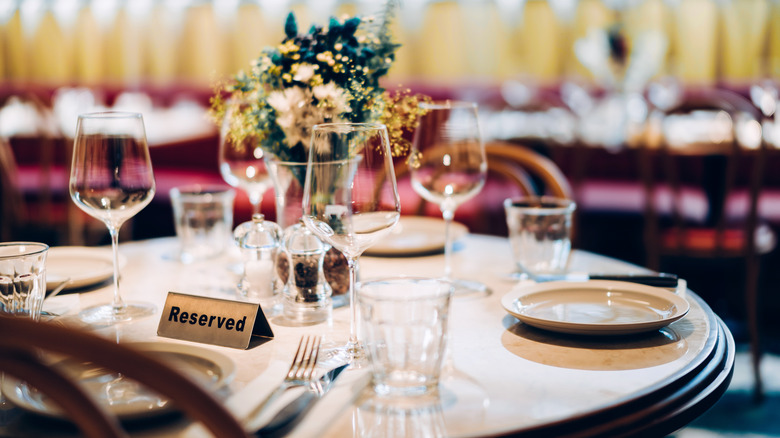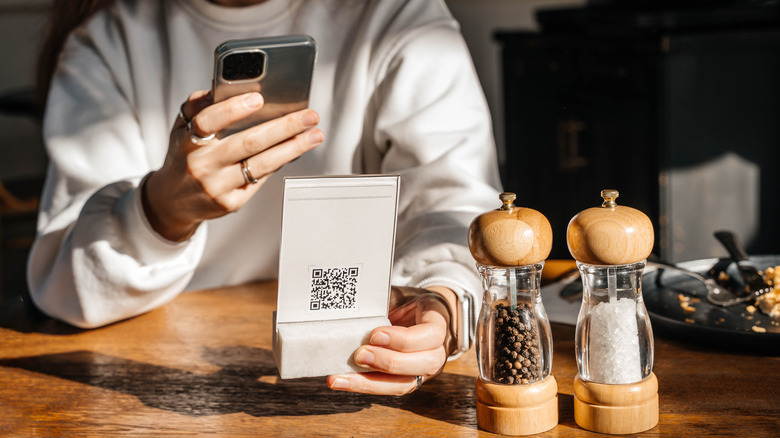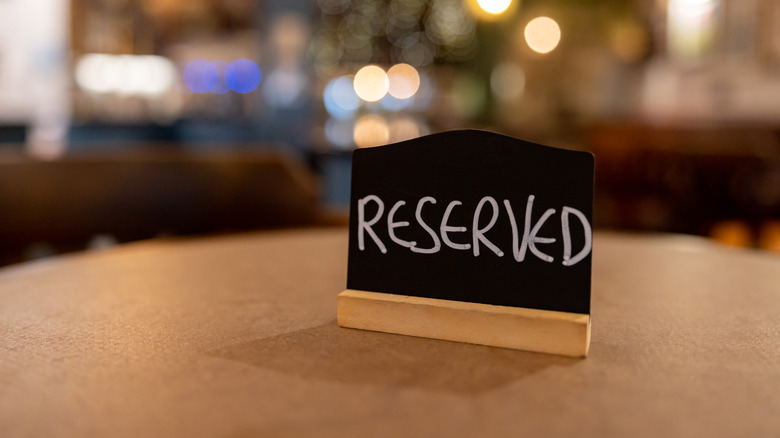Here's What It Means If Your Restaurant Reservation Has A Time Limit
The reservation time limit trend originally began during the early stages of post-COVID-19, as reopening restaurants sought to space out parties and prevent a crowded waiting area. But as folks have filled back in, timed dining has actually become more popular. Nowadays, reservation time limits have emerged as a particularly popular trend in NYC, where many exclusive restaurants already come with tough-to-get reservations.
Practices differ between establishments, but time limits seem to generally fall between 90 minutes and two hours for parties of two to five people. Typically, the time limit begins when your reservation begins. So, if your party arrives 20 minutes late, you now have 70 minutes remaining for dinner instead of the full 90 minutes.
Dining with a time limit might seem offensive or cheap, but it could also seem a bit more logical to anyone who's ever worked in the service industry before. As the owner of Sojourn Social in Manhattan's Upper East Side told local news outlet WDRB, patrons regularly think nothing of posting up on a bar stool for three to five hours, which severely limits the establishment's ability to keep more paying customers coming in. Sojourner Social has now set a 90-minute limit. On the flip side, no one wants to feel rushed. If a server is raring to take your order before you've had a chance to read the menu, that's pretty stressful — especially for something that's supposed to be a relaxing treat and requires you to spend money.
Time limits ensure that there are no double-booked tables
Setting a time limit for parties enables restaurants to offer budget-friendly promotions that rely on volume to be profitable (the opposite infamously befell Red Lobster's Ultimate Endless Shrimp deal). The aforementioned Sojourner Social offers two-for-one drinks during happy hour, which is easy on the wallet for diners and draws traffic. But as the owner elaborated to WDRB, "For us, the goal is, I want you to have a good time, but I need to turn that table. If I'm not turning that table two or three times a night, I'm not making any money."
Interviewed customers at Soujourner's Social responded with basically positive opinions of the imposed time limit. They seemed to agree that 90 minutes was fair, as long as they were given notice about the time limit up front so that they could set their expectation for the night, and as long as the restaurant was busy. It'd seem strange to enforce a limit, noted one patron, during a time when the joint has only a few people in it. Time limits don't just protect a business's bottom line, they're also a practical logistical move for protecting the quality of patrons' dining experiences. If you've arrived for a 9:00 p.m. reservation, but the 7:00 party is still at your table with a leisurely hour-long dessert course in mind, that's going to prevent you from being seated and throw off reservations for the rest of the night.
No one wants to feel rushed at a restaurant, especially when dropping money for the experience
For as logistically smart and revenue-friendly as the reservation time limit is, it can also be potentially overwhelming or even appetite-spoiling for foodies who suddenly find themselves dining on the clock. No one's thrilled to be nursing the final dregs of a wine glass, digesting a hearty plate of pasta, and be told they have to leave before even seeing the dessert menu. At the start of the meal, if your appetizers arrive before your wine for the sake of time, that also stinks. Rushing customers out the door could also impact servers' livelihoods, as any dissatisfaction might prompt a punitive lousy tip.
After being ushered out of Ye's Apothecary, a Sichuan restaurant in NYC's Chinatown, diner Christina Izzo shared a negative experience of the time limit rule with the New York Post. "It was almost like a bodyguard ushering you out of a club after a fight," said Izzo, who tried to order more small plates but was told she couldn't. "I shouldn't have to argue with you [if I] want to spend more money at your establishment." A large aspect of successful customer satisfaction within a limited dining window seems to be up-front communication. Ways to give customers notice about the time limit before their meal begins could include listing it on the reservation booking platform or even having the server reinforce the point to diners at the beginning of their reservation.
Tips for dining under a time limit
At Bonnie's in Brooklyn, parties of eight or fewer are given a two-hour time limit, while larger groups are given three to four hours and a pre-set menu designed for extended dinners. Other establishments, like AG Inspired Cuisine in Niagara Falls, are formatted around a prolonged dining experience and anticipate that guests will sit for longer. As fine dining manager Stephan Voigt tells OpenTable, "Tables of two and four are spending $200 to $600, and we found they would sit for two or three hours."
How (and how much) time limits are enforced seems to vary by restaurant. In general, if your desire is to buckle-in for a slow, extended meal, avoid booking popular, high-traffic restaurants, avoid weekends, and avoid the 7:00-9:00 prime dinnertime slot. Another tip: If you're dining at a restaurant with a time limit, order every dish you want at once up front to avoid running out of time later. If your entree steak takes 20 minutes to prepare and another 20 to savor, put it in at the same time as you order hors d'oeuvres to avoid wasting time. When in doubt, if you realize that maybe you've been sitting there for a while, ask your server if they need the table back — they'll tell you what's up. And no matter what, being kind and understanding to the wait staff is always going to work in your favor for securing a better reservation and overall dining experience.



